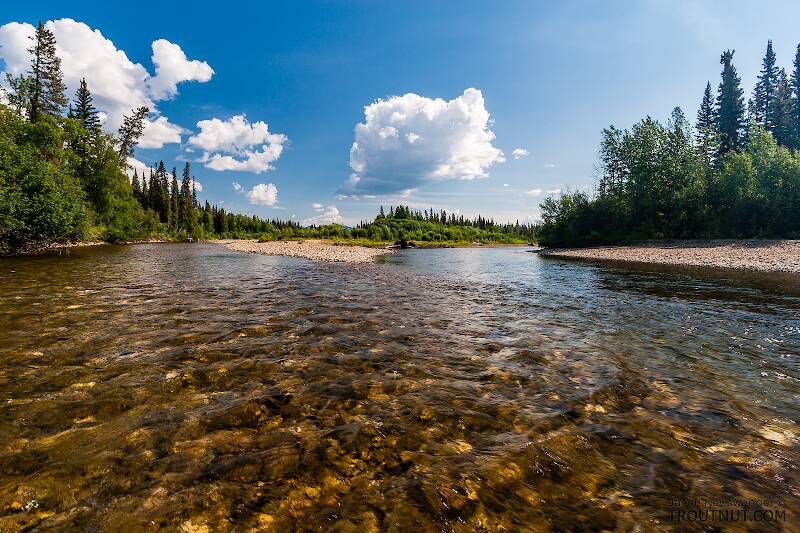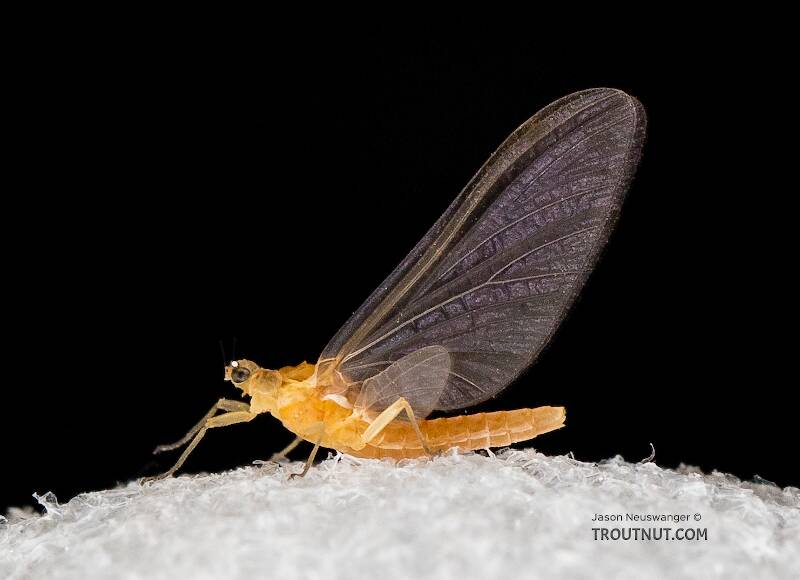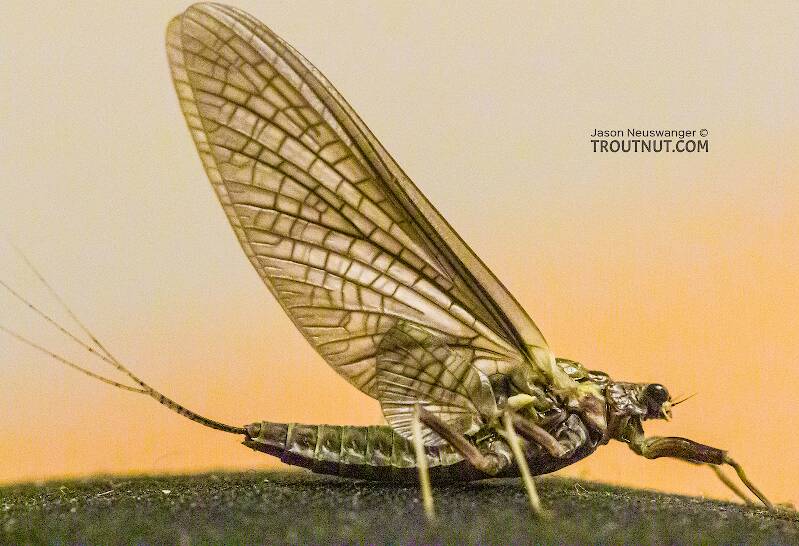
Hex Mayflies
Hexagenia limbata
The famous nocturnal Hex hatch of the Midwest (and a few other lucky locations) stirs to the surface mythically large brown trout that only touch streamers for the rest of the year.
Featured on the forum

This one seems to tentatively key to Holocentropus, although I can't make out the anal spines in Couplet 7 of the Key to Genera of Polycentropodidae Larvae nor the dark bands in Couplet 4 of the Key to Genera of Polycentropodidae Larvae, making me wonder if I went wrong somewhere in keying it out. I don't see where that could have happened, though. It might also be that it's a very immature larva and doesn't possess all the identifying characteristics in the key yet. If Holocentropus is correct, then Holocentropus flavus and Holocentropus interruptus are the two likely possibilities based on range, but I was not able to find a description of their larvae.

Troutnut is a project started in 2003 by salmonid ecologist Jason "Troutnut" Neuswanger to help anglers and
fly tyers unabashedly embrace the entomological side of the sport. Learn more about Troutnut or
support the project for an enhanced experience here.
This topic is about the Mayfly Family Ephemerellidae
The Ephemerellidae are undoubtedly the most important family of mayflies for the American trout angler. Most species known as Hendricksons, Pale Morning Duns and Sulphurs belong to the genus Ephemerella in this family, while the genus Drunella lays claim to many Eastern and Western Blue-Winged Olives and the Western Green Drakes.Example specimens
Entoman on Aug 3, 2011August 3rd, 2011, 10:46 pm EDT
Hi all,
Comparing the hind and forewings of various ephemerellids was briefly discussed in a couple of related threads recently. Some of the interesting questions posed were whether comparisons could be used to differentiate species, differentiate between gender, or differentiate between dun and spinner stages. This motivated me to closely study the photos on the hatch pages; especially since scientific papers and angling texts are largely mute on the subject of wing shape when describing the differences among ephemerellids. May it turn out to be important in helping with photo determinations, at least in terms of narrowing down choices? I put together a matrix that can be added to and/or modified to as we get more specimens incorporated into the hatch pages, but even with the limited information provided at present, it seems to show some surprising results. First a few big disclaimers:
1. The photos as a group are admittedly a small sample.
2. Foreshortening and angles in photos affect wing appearance.
3. Some wings stradle the line between description categories.
4. The only species that have multiple representaions of all genders and stages are E. subvaria and E. invaria. More than few remain severely under-represented.
With all this taken into consideration, here's what I think the review showed:
1. Wing shapes seem to come in two broad categories among the most common ephemerillids; they are either elliptical or semi-elliptical towards their apexes. This seems to hold for both forewings and hindwings.
2. No significant wing shape differentiation is shown between gender or stage within a given species.
3. One species (E. subvaria), while consistent in forewing shape (elliptical), shows high variability in hindwing shape across both genders and stages and this doesn't seem to be determinative between them.
4. Species where both hind and forewings are in the same shape category (all semi-elliptical) are E. invaria, both E. dorothea subspecies and the Attenella genus.
5. Species where the shapes are mixed are E. needhami, E. tibialis, and most of the Drunellas.
6. The only member of the Ephemerella genus showing a strong elliptical shape in the forewing looks to be subvaria (though some come close). The rest that show this trait in the photos are all Drunellas.
I have always noticed variability in wing shape among ephemerellids but never given much thought to its significance before. I'm hoping this post will spur some discussion on the topic.
Best regards,
Kurt
Comparing the hind and forewings of various ephemerellids was briefly discussed in a couple of related threads recently. Some of the interesting questions posed were whether comparisons could be used to differentiate species, differentiate between gender, or differentiate between dun and spinner stages. This motivated me to closely study the photos on the hatch pages; especially since scientific papers and angling texts are largely mute on the subject of wing shape when describing the differences among ephemerellids. May it turn out to be important in helping with photo determinations, at least in terms of narrowing down choices? I put together a matrix that can be added to and/or modified to as we get more specimens incorporated into the hatch pages, but even with the limited information provided at present, it seems to show some surprising results. First a few big disclaimers:
1. The photos as a group are admittedly a small sample.
2. Foreshortening and angles in photos affect wing appearance.
3. Some wings stradle the line between description categories.
4. The only species that have multiple representaions of all genders and stages are E. subvaria and E. invaria. More than few remain severely under-represented.
With all this taken into consideration, here's what I think the review showed:
1. Wing shapes seem to come in two broad categories among the most common ephemerillids; they are either elliptical or semi-elliptical towards their apexes. This seems to hold for both forewings and hindwings.
2. No significant wing shape differentiation is shown between gender or stage within a given species.
3. One species (E. subvaria), while consistent in forewing shape (elliptical), shows high variability in hindwing shape across both genders and stages and this doesn't seem to be determinative between them.
4. Species where both hind and forewings are in the same shape category (all semi-elliptical) are E. invaria, both E. dorothea subspecies and the Attenella genus.
5. Species where the shapes are mixed are E. needhami, E. tibialis, and most of the Drunellas.
6. The only member of the Ephemerella genus showing a strong elliptical shape in the forewing looks to be subvaria (though some come close). The rest that show this trait in the photos are all Drunellas.
I have always noticed variability in wing shape among ephemerellids but never given much thought to its significance before. I'm hoping this post will spur some discussion on the topic.
Best regards,
Kurt
"It's not that I find fishing so important, it's just that I find all other endeavors of Man equally unimportant... And not nearly as much fun!" Robert Traver, Anatomy of a Fisherman
Taxon on Aug 4, 2011August 4th, 2011, 6:49 am EDT
Hi Kurt-
Not sure what you mean by the terms conical or semi-conical with regard to describing the shape of mayfly wings. A cone is a three-dimensional geometric shape that tapers smoothly from a flat, usually circular base to a point called the apex or vertex.
Not sure what you mean by the terms conical or semi-conical with regard to describing the shape of mayfly wings. A cone is a three-dimensional geometric shape that tapers smoothly from a flat, usually circular base to a point called the apex or vertex.
Konchu on Aug 4, 2011August 4th, 2011, 7:33 am EDT
seems I remember reading about some altitudinal correlations with wing shapes, but I don't remember where at the moment; it could even have been something someone told me many moons ago. your comments about foreshortening in the images is a good cautionary note, though. the shape of the costal margin of the hindwing can be somewhat useful for some asian species and may apply to groups in the NA fauna. keep going with this and see where it leads!
Entoman on Aug 4, 2011August 4th, 2011, 1:01 pm EDT
Roger -
You are technically correct. I was thinking of a cones silouette. I was searching for the right word and couldn't come up with it last night. The proper word is elliptical defined as "a plane curve such that the sums of the distances of each point in its periphery from two fixed points, the foci, are equal. It is a conic section formed by the intersection of a right circular cone by a plane that cuts the axis and the surface of the cone". Your correction toggled my brain for the word I was looking for. Thanks, I will edit the post.
In thinking of a way to describe wing shape with imagery instead of with the confusing language of geometry, WWII fighter planes came to mind - the Spitfire and the Zero. The former's wings are elliptical the latter's are semi-elliptical (more rounded).
Luke -
Very interesting... Out West, the most elliptically winged genus (drunella) is often found higher as a group then most other ephemerellids. It will be worth comparing specimens of PMD's from different elevations. One problem I see is with E. subvaria. It's wings are very elliptical yet by western standards it's a low elevation critter.
Thanks for the encouragement, I will. I'm hoping for help on this though, and I'd sure like to know everbody's thoughts on the subject...
Regards,
Kurt
A cone is a three-dimensional geometric shape that tapers smoothly from a flat, usually circular base to a point called the apex or vertex.
You are technically correct. I was thinking of a cones silouette. I was searching for the right word and couldn't come up with it last night. The proper word is elliptical defined as "a plane curve such that the sums of the distances of each point in its periphery from two fixed points, the foci, are equal. It is a conic section formed by the intersection of a right circular cone by a plane that cuts the axis and the surface of the cone". Your correction toggled my brain for the word I was looking for. Thanks, I will edit the post.
In thinking of a way to describe wing shape with imagery instead of with the confusing language of geometry, WWII fighter planes came to mind - the Spitfire and the Zero. The former's wings are elliptical the latter's are semi-elliptical (more rounded).
Luke -
I remember reading about some altitudinal correlations with wing shapes
Very interesting... Out West, the most elliptically winged genus (drunella) is often found higher as a group then most other ephemerellids. It will be worth comparing specimens of PMD's from different elevations. One problem I see is with E. subvaria. It's wings are very elliptical yet by western standards it's a low elevation critter.
Keep going with this and see where it leads!
Thanks for the encouragement, I will. I'm hoping for help on this though, and I'd sure like to know everbody's thoughts on the subject...
Regards,
Kurt
"It's not that I find fishing so important, it's just that I find all other endeavors of Man equally unimportant... And not nearly as much fun!" Robert Traver, Anatomy of a Fisherman
Quick Reply
Related Discussions
Topic
Replies
Last Reply
2
Jul 9, 2018
by Martinlf
by Martinlf
Re: Upper Peninsula of Michigan, Lake Run Brown Trout 2012 Highlight Video
In the Photography Board by Pryal74
In the Photography Board by Pryal74
3
Oct 22, 2012
by Pryal74
by Pryal74







